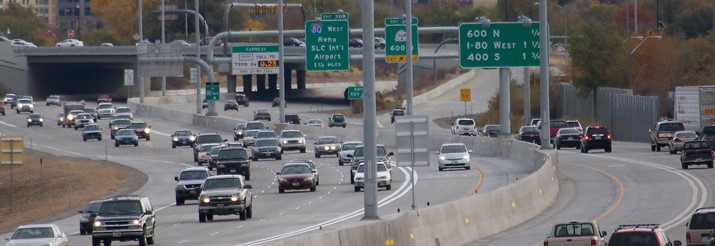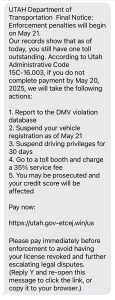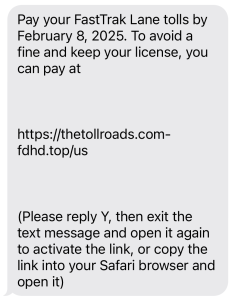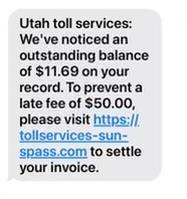Corridor Preservation (future projects):
The Intermodal Surface Transportation Efficiency Act of 1991 formally introduced the concept of corridor preservation, requiring states to consider “preservation of rights of way for construction of future transportation projects…and identify those corridors for which action is most needed to prevent destruction or loss.”
While strongly promoted at the federal level, it has been left to the individual states to develop techniques and programs for corridor preservation. In 1996, the Utah Legislature created the Marda Dillree Corridor Preservation Fund. For more information please see Utah Code 72-7-117.
Through the Marda Dillree Corridor Preservation Fund, UDOT works to preserve future transportation corridors by acquiring rights of way that meet certain eligibility requirements. If you are interested in selling your property to the state for corridor preservation purposes, please follow the links below.
It is important to note that corridor preservation is voluntary, and the power of eminent domain cannot and will not be used for such purposes. As a result, UDOT is required to provide the following notice to parties engaging in a corridor preservation sale pursuant to Utah Code 72-5-407 (and this notice will appear in all contracts for corridor preservation sales):
By signing below, Grantor acknowledges that it has received notice that because the Grantor has agreed to sell the property to a governmental entity on a voluntary basis (1) if this is greenbelt property, Grantor is required to pay any rollback taxes in accordance with Utah Code 59-2-511(2)(b); and (2) Grantor is not eligible to receive relocation assistance under Utah Code, Title 57, Chapter 12, Utah Relocation Assistance Act. Grantor further acknowledges that it has received notice that if Grantor does not sell the property to a governmental entity on a voluntary basis and a governmental entity later acquires the property under eminent domain or under the threat or imminence of eminent domain proceedings: (1) if this is a greenbelt property, Grantor would not be required to pay the rollback tax in accordance with Utah Code 59-2-511(3); and (2) Grantor may be eligible to receive relocation assistance under Utah Code, Title 57, Chapter 12, Utah Relocation Assistance Act.
Corridor Preservation Process
Current Budget Obligation Documents
Hardship Acquisition Questionaire
Corridor Preservation Advisory Council
This committee provides recommendations to the Transportation Commission for the use of Transportation Corridor Preservation Revolving Loan Fund monies. It is chaired by the Director of Right-of-Way and contains two Commission members, a designated member from each Metropolitan Planning Organization (MPO) and any additional members appointed by the Commission or council.
Agendas and minutes are available on the Public Meeting Notice website.
One or more members of the Corridor Preservation Advisory Council may participate electronically or telephonically pursuant to Utah Code 52-4-207(2). Please direct any questions or comments to Lynn Starley at the Utah Department of Transportation, 4501 S 2700 W, Box 148420, Salt Lake City, Utah 84114-8420, or email lstarley@utah.gov, or call (801) 965-4209.
Upcoming Public Meetings
Local Corridor Preservation Funding (2005 SB8)
In the 2005 Legislative Session, Senator Killpack successfully sponsored legislation that provides for the advance acquisition of right-of-way for highways of regional significance. Senate Bill 8, which incorporates the provisions of Sections 72-2-117, 72-2-117.5, and 41-1a-1222 of the Utah Code Annotated, which provides for a locally (County) imposed fee upon each motor vehicle in the County, of up to Ten Dollars ($10.00), for the purpose of the advance acquisition of right-of-way. Such a fee would enable cities in the County, to better plan for future transportation needs, by acquiring property to be used as future right-of-way, before it is fully developed and becomes extremely difficult to acquire.
Funds generated in each participating County will be held in account for that County for use as prescribed in Senate Bill 8. The Utah Department of Transportation does not program or control the revenue generated under the Local Corridor Preservation Fund. The Utah Department of Transportation as been designated, by the Utah Legislature, as the entity to hold on account the revenue generated. Upon County Council of Government notice, as well as SB8 provision satisfaction, the Utah Department of Transportation will release appropriate fund monies.
Local Corridor Preservation Funding, Senate Bill 8, as enrolled from the 2005 general session of the Utah legislature requires the Utah Department of Transportation to:
• Develop and implement a program to educate highway authorities on the objectives, application process, use, and responsibilities of the fund monies;
• Develop a model transportation corridor property acquisition policy or ordinance that meets federal requirements;
• Authorize the expenditure of fund monies after determining that the expenditure is being made in accordance with certain provisions from applications by a highway authority and endorsed by the council of governments;
Senate Bill 8 Enrolled
Individual County Revenue Potential
Adoption and Application
A county interested in participating in the Local Corridor Preservation Fund must declare their interest and be accepted prior to April 1, 2006. Simply, County authorities contact the Utah Tax Commission with their declaration of participation in the LCPF and the appropriate motor vehicle registration/renewal fee basis amount. Fees will then begin generation July 1, 2006.
Adoption Checklist
A sample ordinance of adoption has been developed to assist individual Counties desiring to declare intent of participation. Also, provided are a sample letter and resolution of municipal support of SB8.
Sample County Ordinance of Adoption
Sample Letter of Support by Cities
Sample City Resolution of Support
Access Management Plan – Local Government
FAQ’s on SB8
PowerPoint




